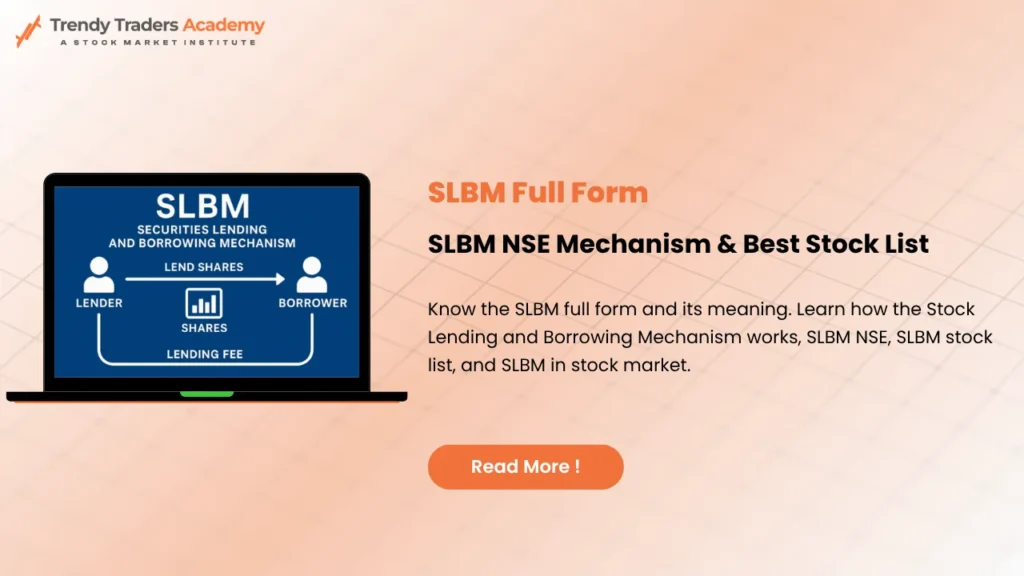
SLBM Full Form: SLBM NSE Mechanism & Best Stock List Guide
The SLBM full form is Stock Lending and Borrowing Mechanism, is a regulated system in the Indian stock market that allows one investor to lend shares and another to borrow them for a defined fee and duration. The SLBM facility enables temporary transfer of shares without changing ownership, supporting short selling and liquidity. It has become a mainstream tool for traders seeking flexibility in managing positions.
The SLBM mechanism is overseen by NSE and SEBI, and it plays a larger role in improving liquidity, reducing settlement issues, and supporting short-selling. As the market becomes more sophisticated, understanding SLBM is becoming essential for anyone who wants to participate beyond basic delivery trading.
This detailed blog explains the meaning of SLBM, how the system works, who uses it, and why SLBM in stock market matters. The goal is to break the topic down in a simple, factual, and practical way so any trader can understand it without prior background knowledge.
What is SLBM Full Form?
The SLBM full form is Stock Lending and Borrowing Mechanism. It is a framework that allows investors to temporarily lend their shares to other traders in exchange for a lending fee. On the other hand, traders who need shares for short selling or settlement can borrow the same shares for a fixed period through the SLBM platform.
In simple terms:
- A lender provides shares.
- A borrower takes shares for a defined period.
- Both sides transact through a regulated system on NSE.
- The entire process is legal, transparent, and monitored by clearing corporations to ensure the safety of both lender and borrower.
Why SLBM in Stock Market Matters?
SLBM in stock market trading adds depth and stability. Without it, short selling would be nearly impossible. The SLBM mechanism also helps in improving price discovery and reducing volatility because traders can express both bullish and bearish views responsibly. Platforms like NSE have made SLBM more accessible for retail investors.
Who Uses SLBM?
- Long-term investors
- Retail traders
- Hedge funds
- Arbitrage traders
- Institutions managing large portfolios
Different users participate for different reasons. Some lend shares to earn an extra return. Others borrow shares to execute arbitrage, hedge positions, or short sell during events like result announcements or index rebalancing.

How the SLBM Mechanism Works?
To understand SLBM mechanism simply, break the process into four stages:
Share Lending
An investor who holds shares long-term can lend them for a fee. The shares move out of their demat temporarily but they retain economic benefits like dividends, bonuses, and corporate actions.
Share Borrowing
A trader who wants to short sell or needs shares for settlement borrows the stock. They agree to return the shares on the agreed expiry date.
Margin and Risk Management
Both sides must provide margins. NSE Clearing Corporation holds these margins and ensures no default occurs.
Settlement and Return
On the SLBM expiry date, the borrower returns the shares. The lender receives the stock back along with the lending fee.
Everything happens through the exchange. There is no direct contact between lender and borrower.
SLBM NSE Cycle and Contract Tenure
SLBM NSE contracts are available for different tenures:
- 1 month
- 3 months
- Up to 12 months in some stocks
Contracts expire on the last Thursday of every month, similar to derivatives. Traders can see available contracts, lending fees, and borrowing rates on the SLBM NSE platform.
Which Stocks Are Available for SLBM?
Not all stocks trade under SLBM. The SLBM stock list is selected based on:
- Liquidity
- Market capitalization
- Presence in F&O segment
- Regulatory filters
Stocks in the F&O list automatically become more active under SLBM because traders often borrow them for short selling. Large-cap names make up a significant part of the SLBM stock list.
Example of SLBM stocks
- Reliance Industries
- Infosys
- HDFC Bank
- TCS
- ICICI Bank
- LT
- Maruti Suzuki
(Actual availability varies daily on NSE).
Step-by-Step Procedure to Participate in SLBM
1. Activate the SLBM Feature
- To begin, traders must enable the SLBM facility in their trading account.
- Most brokers offer a simple activation option within their app or dashboard.
- Once the request is approved, you can start lending or borrowing shares through the SLBM segment.
2. Check Stock Availability
- After activation, the next step is to see which stocks are eligible for SLBM.
- The NSE publishes a list of approved stocks every day.
- This list helps traders identify the shares they can lend or borrow based on availability and current market interest.
3. Review Lending or Borrowing Fees
- Before placing an order, traders should check the prevailing fees.
- These charges are influenced by demand and supply.
- When a stock is in high demand for short selling, the borrowing fee usually increases.
- Lenders benefit from this as they earn a higher return, while borrowers must pay a higher charge to access those shares.
4. Place Your Order
- Once you’ve reviewed the fees, you can submit an SLBM order through your broker.
- You must choose the contract month, the number of shares, and the price at which you want to lend or borrow.
- The order then goes to the SLBM market, where it is matched with a counterparty.
5. Settlement of the Trade
- All SLBM transactions are settled through the clearing corporation, ensuring the process is secure and transparent.
- The clearing body handles the transfer of shares, fees, and guarantees that both parties fulfil their obligations.
6. Return or Receive Shares at Maturity
- At the end of the contract period, borrowers must return the shares they borrowed.
- Lenders automatically receive the lending fee for the duration their shares were lent out.
- The entire process is handled seamlessly through the clearing corporation, making SLBM participation structured and reliable.

Why Do Traders Borrow Shares Through SLBM?
Short Selling
If a trader expects a stock to decline, they can borrow shares and sell them first, then buy back at a lower price.
Arbitrage Opportunities
Arbitrageurs use SLBM to exploit price differences between the cash market, futures market, and ETFs.
Avoiding Penalties
If a trader mistakenly sells shares they do not have, borrowing helps them avoid short delivery penalties.
Meeting Institutional Requirements
Mutual funds and PMS sometimes need SLBM to rebalance portfolios.
Why Investors Lend Shares
Long-term investors often hold shares for many months or years. SLBM helps them earn extra income from these idle holdings.
Key advantages for lenders:
- Earn a lending fee
- No loss of ownership
- No tax impact
- No impact on long-term holding period
- Low effort, as everything is handled through brokers and clearing corporations
Risks in SLBM
No financial product is risk-free, and SLBM has its own considerations.
- Counterparty default risk
- Market volatility
- Low liquidity in some counters
- Corporate actions may impact contracts
However, clearing corporations maintain strict margin rules and guarantee settlement, which reduces risk significantly.
SLBM in stock market Charges
The overall cost includes:
- Borrowing fee (varies stock to stock)
- Brokerage charges
- Clearing corporation fees
- GST on fees
Lenders receive lending fees credited to their account. Borrowers pay all applicable charges.
Example: How Borrowing Through SLBM Works
- A trader expects Stock X to fall from 1000 to 950.
- Borrow 100 shares via SLBM
- Sell them in the cash market at 1000
- Buy back at 950
- Return shares on maturity
- Profit before charges = (1000 – 950) × 100 = 5,000
Borrowing fees and taxes will reduce net earnings but the strategy still works if the price move is strong.
Conclusion
SLBM in stock market trading is no longer a product designed only for institutions. As the Indian market evolves, retail traders are increasingly exploring SLBM to hedge, short sell, or generate passive income. Understanding SLBM full form, how the contracts function on NSE, and how the SLBM stock list is chosen can help traders make more informed decisions.
Whether you want to lend idle shares or borrow stocks for strategic trades, the SLBM mechanism adds another layer of flexibility to modern trading. A well-regulated framework, clear risk controls, and reliable settlement make SLBM an important tool for serious market participants.
FAQ'S
What is SLBM?
SLBM is the Stock Lending and Borrowing Mechanism, a regulated system that allows investors to lend or borrow shares for a fixed period and fee.
What is the SLBM full form?
The SLBM full form is Stock Lending and Borrowing Mechanism.
Is SLBM available on NSE?
Yes. SLBM NSE is the most active platform in India for lending and borrowing equity shares.
Which stocks are part of the SLBM stock list?
Mostly large-cap and F&O listed companies. The updated list is released by NSE every trading day.
Why do traders borrow shares under SLBM Mechanism?
They borrow shares mainly for short selling, arbitrage, and avoiding delivery shortfalls.
Do lenders lose ownership during SLBM?
No. They keep ownership and remain eligible for dividends, bonuses, and other benefits.
Are SLBM in stock market profits taxable?
Lending fees are considered income, while normal capital gain rules apply to stock transactions.









